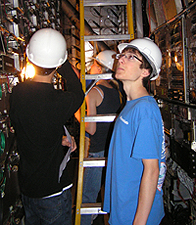This story first appeared in Fermilab Today on January 28, 2011.
While perhaps fatal to felines, curiosity is a motivating force for one local high school student. Seventeen-year-old Ike Swetlitz spent his summer at Fermilab on the hunt for the Higgs boson with DZero physicists.
On his quest for answers about the fundamental nature of matter and the universe, Swetlitz contacted Fermilab and arranged to spend his summer holiday working side by side with DZero experiment collaborators.
Swetlitz worked on one problem in particular over the summer. The DZero team tasked him with dissecting a few troublesome particle collision events to discover what the data was really reporting.
He published his work as an internal document that was used and praised by members of the DZero collaboration. He also submitted his work to the Intel Science Talent Search and qualified as a semifinalist, taking home $1,000 dollars for himself, and another $1,000 for Naperville Central High School.
“The collisions I was looking at hit some triggers that made them seem like Higgs boson events. My project was to look at that data and verify them as Higgs events, or find out what errors were happening so we could improve the program,” Swetlitz said.
With the help of his advisors, Swetlitz learned which variables pushed the DZero computers to falsely record the events as Higgs-like, allowing the collaboration to look for better ways to examine data and exclude similar events in the future.
“He’s not afraid to ask questions,” said Brendan Casey, who worked with Swetlitz at DZero. “Ike always wants to go one step further, and he’ll keep asking questions until he really understands the answers.”
Bjoern Penning, Swetlitz’s primary supervisor over the summer, was amazed how fast Swetlitz became an asset to the laboratory.
“Within a few days he was using our software and extending it to his purposes. The document he produced made a real contribution to the collaboration,” Penning said.
As he applies to colleges, Swetlitz plans to go wherever his curiosity takes him. He is considering a dual major in physics and philosophy.
“I’m not only curious about physics and what the universe is fundamentally made of. I also want to look at the existential questions related to why we are here,” Swetlitz said.







